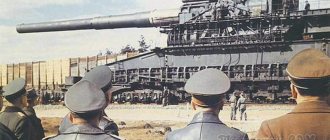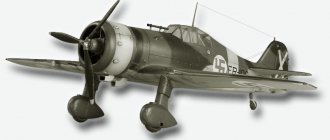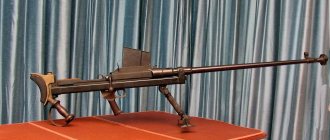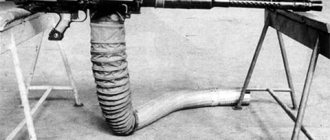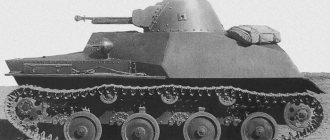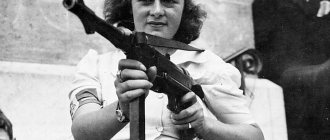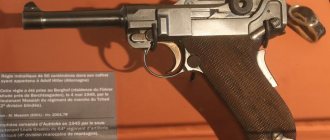Author: tajily
November 21, 2016 11:46
Tags: Wunderwaffe Miracle technology military equipment Germany second world war
276794
16
The name "wunderwaffe", or "miracle weapon", was coined by the German Ministry of Propaganda and was used by the Third Reich for a number of large-scale research projects aimed at creating a new type of weapon, its size, capabilities and functions many times superior to all existing models.
1
Source:
See all photos in the gallery
Wonder weapon, or “Wunderwaffe”... During the Second World War, the Ministry of Propaganda of Nazi Germany called its superweapon, which was created according to the latest science and technology and in many ways was supposed to become revolutionary during the conduct of hostilities. It must be said that most of these miracles never entered production, barely appeared on the battlefield, or were created too late and in too small quantities to have any impact on the course of the war. As events progressed and Germany's position worsened after 1942, claims about the Wunderwaffe began to cause noticeable inconvenience to the Propaganda Ministry. Ideas are ideas, but the reality is that the release of any new weapon requires lengthy preparation: it takes years to test and develop. So hopes that Germany could perfect its mega-weapon by the end of the war were in vain. And the samples that entered service caused waves of disappointment even among the German military devoted to propaganda. However, something else is surprising: the Nazis actually had the technological know-how to develop many wonderful innovations. And if the war had dragged on much longer, then there was a possibility that they would have been able to perfect the weapons and establish mass production, changing the course of the war. The Axis powers could have won the war. Fortunately for the Allies, Germany was unable to capitalize on its technological advances. Here are 15 examples of Hitler’s most formidable “wunderwaffe”.
×
Self-propelled mine Goliath
0
Source:
“Goliath”, or “Sonder Kraftfarzeug” (abbr. Sd.Kfz. 302/303a/303b/3036) is a ground-based tracked self-propelled mine. The Allies called "Goliath" by a less romantic nickname - "gold pan". "Goliaths" were introduced in 1942 and were a tracked vehicle with dimensions of 150 × 85 × 56 cm. This design carried 75-100 kg of explosives, which is a lot, given its own height. The mine was designed to destroy tanks, dense infantry formations and even destroy buildings. Everything would be fine, but there was one detail that made the Goliath vulnerable: the wedge without a crew was controlled by wire at a distance. The Allies quickly realized that to neutralize the machine, all they had to do was cut the wire. Without control, Goliath was helpless and useless. Although a total of over 5,000 Goliaths were produced, their design was ahead of modern technology, the weapon was not successful: high cost, vulnerability and low maneuverability played a role. Many examples of these “killing machines” survived the war and today can be found among museum exhibits throughout Europe and the United States.
Needs and real opportunities
Calculations, carried out for the first time in relation to protected ground vehicles, determined the total operational requirements of the German Armed Forces in the amount of 20 thousand armored vehicles.
The high cost of procurement, combined with military budget restrictions, made it impossible to meet them. As a result, when planning the reform of the Bundeswehr, an approach was implemented aimed at concentrating forces and resources on possible operations and on preparing troops for their conduct.
The approach is reflected in the “Concept for equipping armored wheeled and tracked vehicles for Bundeswehr tasks” (Konzept zur Ausstattung mit geschützten Rad- und Kettenfahrzeugen für die Aufgaben der Bundeswehr), in force since June 2011. According to the developers, the new concept can guarantee the satisfaction of the structural needs of the aircraft by 80 percent.
At the same time, the overall financial costs of the concept remained high for the military budget. As a result, in 2012, the upper limit of armored vehicles was set for the Bundeswehr in the amount of 7 thousand units. This figure has effectively cemented the shortage of protected vehicles for foreign military missions in the near future.
In total, the German Armed Forces are planned to have 54 thousand vehicles, of which:
- 7 thousand units armored vehicles: main structural-defining weapon systems (Leopard 2 MBT, Puma BMP, PzH 2000 self-propelled guns, etc.), plus wheeled armored vehicles of the BKMA, BTA and ZSA categories;
- 9 thousand unprotected cars in military units;
- 38 thousand vehicles of the so-called “flexible component”.
The said “flexible component” is managed by (Bw-Fuhrparkservice GmbH) and is intended for proportional use by the Bundeswehr at home and abroad. Transport of military units provided under an outsourcing agreement.
Company logo Bw-Fuhrparkservice GmbH
Artillery gun V-3
0
Source:
Like its predecessors, the V-1 and V-2, the "Punitive Weapon", or V-3, was another in a series of "vengeance weapons" aimed at wiping out London and Antwerp from the face of the earth. The “English gun,” as it was sometimes called, the V-3 was a multi-chambered gun designed specifically for the landscape where Nazi troops were stationed, shelling London across the English Channel. Although the projectile range of this “centipede” did not exceed the firing range of other German experimental artillery guns due to problems with the timely ignition of auxiliary charges, its rate of fire should theoretically be much higher and reach one shot per minute, which would allow the battery of such guns to literally fall asleep London is shelled. Tests in May 1944 showed that the V-3 could fire at a range of up to 58 miles. However, only two V-3s were actually built, and only the second was actually used in combat. From January to February 1945 the cannon fired 183 times in the direction of Luxembourg. And it proved its complete… failure. Of the 183 shells, only 142 landed, 10 people were shell-shocked, and 35 were wounded. London, against which the V-3 was created, turned out to be unattainable.
Artillery[ | ]
In the German army, artillery guns were divided into anti-tank, infantry, medium and heavy, as well as anti-aircraft. Anti-tank guns included 3.7 cm PaK 35/36, 5 cm PaK 38 and 7.5 cm PaK 40[7], and infantry guns 7.5 cm leIG 18 and 15 cm sIG 33. Medium and heavy artillery guns were represented by 10, 5 cm leFH 18, 15 cm sFH 13 and 15 cm sFH 18.
Anti-aircraft artillery used 2 cm FlaK 30, 3.7 cm FlaK 18, 3.7 cm FlaK 43, as well as 8.8 cm FlaK 18/36/37 and 10.5 cm FlaK 38/39.
Guided aerial bomb Henschel Hs 293
0
Source:
This German guided bomb was perhaps the most effective guided weapon of World War II. She destroyed numerous merchant ships and destroyers. The Henschel looked like a radio-controlled glider with a rocket engine underneath and a warhead containing 300 kg of explosives. They were intended for use against unarmored ships. About 1,000 bombs were manufactured for use by German military aircraft. A variant for use against armored vehicles Fritz-X was produced a little later. After dropping the bomb from the plane, the rocket booster accelerated it to a speed of 600 km/h. Then the planning stage began towards the target, using radio command control. The Hs 293 was aimed at the target from the aircraft by the navigator-operator using the handle on the Kehl transmitter control panel. To prevent the navigator from visually losing sight of the bomb, a signal tracer was installed on its “tail.” One of the disadvantages was that the bomber had to maintain a straight trajectory, moving at a constant speed and altitude, positioned parallel to the target in order to maintain some visible line with the missile. This meant that the bomber was unable to divert and maneuver as incoming enemy fighters attempted to intercept it. The use of radio-controlled bombs was first proposed in August 1943: then the first victim of the prototype of the modern anti-ship missile was the British sloop HMS Heron. However, it didn’t take long for the allies to look for an opportunity to connect to the missile’s radio frequency in order to throw it off course. It goes without saying that the discovery of Henschel's control frequency significantly reduced its efficiency.
Panzerwaffe - Armored Forces
You might be interested in: Lever: equilibrium condition. Lever equilibrium condition: formula
Tanks, invented by the British, were used primarily for defense during the First World War. In the Wehrmacht army, armored forces became the dominant offensive force of ground forces. By the beginning of the war, Germany had three thousand one hundred and ninety tanks. Tanks, like all German military equipment of World War II, were equipped with modern weapons. After the annexation of Czechoslovakia, the Wehrmacht armored forces were replenished with 369 Czech-made tanks.
You will be interested: What is this path? Origin, meaning, use
Up to eighty percent of the German tank force consisted of Panzerkampfwagen III and IV medium tanks.
Silver Bird
0
Source:
The Silver Bird is a project of a high-altitude partially orbital bomber-spacecraft by the Austrian scientist Dr. Eugen Senger and physicist Irena Bredt. Originally developed in the late 1930s, the Silbervogel was an intercontinental spaceplane that could be used as a long-range bomber. He was considered for the America Bomber mission. It was designed to carry more than 4,000 kg of explosives, equipped with a unique CCTV system, and was believed to be invisible. Sounds like the ultimate weapon, doesn't it? However, it was too revolutionary for its time. Engineers and designers faced all sorts of technical and other difficulties, sometimes insurmountable, in connection with the “birdie”. For example, the prototypes overheated greatly, and no means of cooling had yet been invented... Ultimately, the entire project was canceled in 1942, and money and resources were directed to other ideas. Interestingly, after the war, Zenger and Bredt were highly regarded by the expert community and participated in the creation of the French National Space Program. And their “Silver Bird” was taken as an example of a design concept for the American project X-20 Daina-Sor... Until now, a design project called “Zengera-Bredt” is used for regenerative cooling of the engine. Thus, the Nazi attempt to create a long-range space bomber to attack the United States ultimately contributed to the successful development of space programs around the world. It's for the better.
Army aviation and air defense of the Bundeswehr
As for the Bundeswehr army aviation, it includes the following types of helicopters:
- 38 powerful Tiger attack helicopters. Although the Bundeswehr's immediate plans included the purchase of another 20 units of such equipment, budget cuts are unlikely to contribute to their implementation;
- 118 VO-105 light attack helicopters, which can also be used as multi-purpose helicopters. Another 24 helicopters of this model are in storage, but it is unknown what condition they are in. Given the Army's old habit of dismantling Army equipment, it is unlikely that they are in combat condition;
- 93 CH-53G transport helicopters;
- 93 multi-role UH-1D and 39 EC-135 units;
- The most modern helicopters are 77 NH-90 units.
If all these helicopters are in combat condition, then the position of the Bundeswehr army aviation is quite stable.
The army's air defense system is represented by 50 units of Ocelot air defense systems, which are in fact nothing more than 4 Stinger MANPADS launchers, which are installed on the chassis of the Wiesel combat vehicle. There is no need to say that the Stingers are quite outdated weapons in modern realities, although during battles with a technically backward enemy they pose a significant threat to targets located at low altitudes.
1944 assault rifle StG-44
0
Source:
Many consider the StG 44 assault rifle as the first example of an automatic weapon. The rifle design was so successful that modern assault rifles such as the M-16 and AK-47 adopted it as their basis. Legend has it that Hitler himself was greatly impressed by the weapon. The StG-44 had a unique design that took advantage of the characteristics of a carbine, an assault rifle, and a submachine gun. The weapon was equipped with the newest inventions of its time: optical and infrared sights were installed on the rifle. The latter weighed about 2 kg and was connected to a battery of about 15 kg, which the shooter carried on his back. It's not compact at all, but very cool for the 1940s! The rifle could also be equipped with a “curved barrel” to fire around corners. Nazi Germany was the first to try to implement this idea. There were different variations of the "bent trunk": 30°, 45°, 60° and 90°. However, they had a short lifespan. After firing a certain number of rounds (300 for the 30° version and 160 rounds for the 45° version), the barrel could be ejected. StG-44 was a revolution, but too late to have a real impact on the course of the war in Europe.
The country's current operations abroad
As of early 2015, the German army is conducting ongoing military operations in the following regions:
- Afghanistan (900 people).
- Uzbekistan (100 people).
- Kosovo (763 people).
- Mediterranean Sea (800 people).
- Somalia (241 people).
- Mali (144 people).
- Lebanon (128 people).
- Bosnia and Herzegovina (120 people).
- Sudan (10 people).
Germany is involved in all these operations, whose army is involved mainly in the form of full-time workers or personnel from the rear support units. It is noteworthy that the combat component of the army does not exceed 10% of its strength, and in general the country deliberately does not participate in new operations abroad, especially if it has to operate in contact infantry combat, in which German soldiers are obviously weaker.
Fat Gustav
0
Source:
"Fat Gustav" is the largest artillery piece that was built during World War II and used for its intended purpose. Developed at the Krupp factory, the Gustav was one of two super-heavy railway guns. The second was "Dora". The Gustav weighed about 1,350 tons, and could fire a 7-ton projectile (bullets the size of two oil drums) at a range of up to 28 miles. Impressive, isn't it?! Why didn't the Allies surrender and admit defeat as soon as this monster was released on the warpath? It took 2,500 soldiers and three days to build double train tracks to maneuver the thing. For transportation, “Fat Gustav” was disassembled into several components and then assembled on site. Its size prevented the cannon from being assembled quickly: it took only half an hour for just one barrel to be loaded or unloaded. Germany was reported to be attaching an entire Luftwaffe squadron to the Gustav to provide cover for its assembly. The only time the Nazis successfully used this mastodon for battle was the siege of Sevastopol in 1942. "Fat Gustav" fired a total of 42 shells, nine of which hit the ammunition depots located in the rocks, which were completely destroyed. This monstrosity was a technical marvel, as terrifying as it was impractical. Gustav and Dora were destroyed in 1945 to prevent them from falling into Allied hands. But Soviet engineers were able to restore the Gustav from ruins. And his traces are lost in the Soviet Union.
Upgraded tanks
Since 1995, all tanks that were modernized began to be called “Leopard-2A5”. As of 2015, there are about 470 of them. And those tanks that did not pass the program are sold to third world countries. Since 2001, another 225 vehicles have been modernized, which have become the most modern and equipped and are called “Leopard-2A6”. New models began to be equipped with enhanced turret armor and additional mine protection.
The German tank army, in particular the modified tank, is attracting attention with the new Rhl 120/L55 gun - with a longer barrel, which increases the firepower of the vehicle and expands the range of ammunition used. On-board electronics have become more advanced and modern, with a new information management system. The tank began to weigh 62 tons, and in general its technical characteristics became much better.
Fritz-X radio controlled bomb
0
Source:
The Fritz-X guided radio bomb, like its predecessor Hs 293, was created to destroy ships. But, unlike the Hs, the Fritz-X could hit heavily armored targets. "Fritz-X" had excellent aerodynamic properties, 4 small wings and a cruciform tail. In the eyes of the Allies, this weapon was the embodiment of evil. The ancestor of the modern guided bomb, the Fritz-X could carry 320 kg of explosives and was controlled using a joystick, making it the world's first precision-guided weapon. This weapon was used very effectively near Malta and Sicily in 1943. On September 9, 1943, the Germans dropped several bombs on the Italian battleship Rome, claiming to have killed everyone on board. They also sank the British cruiser HMS Spartan, the destroyer HMS Janus, the cruiser HMS Uganda and the hospital ship Newfoundland. This bomb alone put the American light cruiser USS Savannah out of action for a year. In total, more than 2,000 bombs were made, but only 200 were dropped on targets. The main difficulty was that if they could not suddenly change the direction of flight. As in the case of the Hs 293, the bombers had to fly directly over the object, which made them easy prey for the Allies - the Nazi aircraft began to suffer heavy losses.
Ground forces: weapons
The ground forces of the German state are armed with:
- Main battle tank – 1095;
- Field artillery gun – 644;
- MLRS and mortars;
- Armored combat vehicle - 2563 (736 of them are armored personnel carriers);
- Combat helicopter - 146.
Formally everything is in order with these ground weapons, but in practice things are a little different. Military experts note that the general state of affairs in the army is far from ideal. This also applies to the level of training of military personnel and the provision of modern weapons. It seems that if martial law is declared in Germany, it is unlikely that its army with its existing equipment and weapons will be able to withstand more militarily powerful states.
Mouse
0
Source:
The full name of this fully enclosed armored vehicle is Panzerkampfwagen VIII Maus, or “Mouse”. Designed by the founder, it is the heaviest tank in the entire history of tank building: the German super-tank weighed 188 tons. Actually, its mass ultimately became the reason why “Mouse” was not put into production. It didn't have a powerful enough engine to propel this beast at acceptable speeds. According to the designer's specifications, the "Mouse" was supposed to run at a speed of 12 miles per hour. However, the prototype could only reach 8 mph. In addition, the tank was too heavy to cross the bridge, but it had the ability to pass under water in some cases. The main use of the Mouse was that it could simply push through enemy defenses without fear of any damage. But the tank was too impractical and expensive. When the war ended, there were two prototypes: one was completed, the second was under development. The Nazis tried to destroy them so that the Mice would not fall into the hands of the Allies. However, the Soviet army salvaged the wreckage of both tanks. At the moment, only one Panzerkampfwagen VIII Maus tank has survived in the world, assembled from parts of these specimens, in the Armored Museum in Kubinka.
German Army Navy
The German Navy, even in the face of military budget cuts, is sufficiently equipped and modern. At the same time, it is not able to solve any serious combat missions, since it is quite budget-friendly. Its tasks include solving local problems, such as coastal protection or intelligence activities.
It should be noted that military shipbuilding in Germany is one of the most modern in the world, and warships and submarines are bought up by various countries with great pleasure. Despite the high prices of submarines (about $330 million for a Type 212 in the “base”), they are in stable demand and bring constant income to the German economy.
Judging by the new German warships that are being built, they are clearly planning to place some new and powerful weapons on them.
The naval aviation of the German Navy also does not represent a significant force and is represented by the following types of equipment:
- 8 R-3C Orion aircraft, which are designed to combat submarines;
- 3 patrol Do-228;
- 43 helicopters of the Sea King and Super Lynx models.
Judging by the state of military shipbuilding in Germany, in the event of a large-scale military conflict, Germany will be able to acquire a powerful military fleet in a short time.
Rat
0
Source:
Did you think the Mouse tank was big? Well... Compared to the Landkreuzer P. 1000 Ratte projects, it was just a toy! "Rat" Landkreuzer P. 1000 - the largest and heaviest tank designed by Nazi Germany! According to the plans, this land cruiser was supposed to weigh 1000 tons, be about 40 meters long, and 14 meters wide. It housed a crew of 20 people. The huge size of the car was a constant source of headaches for designers. It was too impractical to have such a monster in service, since, for example, many bridges would not support it. Albert Speer, who was responsible for coming up with the idea for the Rat, thought the tank was ridiculous. It was thanks to him that construction did not even begin, and not even a prototype was created. At the same time, even Hitler doubted that the “Rat” could actually perform all its functions without special preparation of the battlefield for its appearance. Speer, being one of the few who could imagine land battleships and high-tech miracle machines in Hitler's fantasies, canceled the program in 1943. The Fuhrer was satisfied, since he relied on other weapons for his quick attacks. Interestingly, in fact, during the winding down of the project, plans were drawn up for an even larger land cruiser, the P. 1500 Monster", which would carry the heaviest weapon in the world - the 800-mm cannon from "Dora"!
"Panther"
Today no one denies the fact that the German heavy tank Pz. Kpfw V "Panther" was created in the image and likeness of the Soviet "thirty-four". Just look at the shape of their hull and turret. Already in the first days of the war, shocked by the power and invulnerability of Soviet tanks, the commander of armored forces , General Heinz Guderian, demanded that German designers carefully study the T-34 tank and immediately begin its serial production in Germany. At Guderian's suggestion, a special commission was urgently created to study captured Russian tanks. The commission confirmed Guderian's opinion about the T-34's outstanding design features. At the same time, she noted that the Russians were able to create such advanced tanks and diesel engines for them that it would be impossible to copy them in German factories. The only thing that remained for the Germans was to do at least something similar. Thus began work on the future “Panther”.
Until the end of the war, the Germans produced 6 thousand Panthers. It was the second most popular (after the T-IV) Wehrmacht tank
During the design of the new tank, the Germans tried to equip it with the most powerful gun of all guns, with a caliber of 75 mm, and cover it with impenetrable armor , the thickness of which was almost twice the thickness of the armor of the T-34 tank and reached 80 mm in the frontal part of the hull. The result was not a medium tank, as Guderian wanted it to be, but a real, 45-ton heavy tank. The Germans considered the Panther their best tank, and therefore devoted all their efforts to launching its mass production.
During the fighting it became clear that the Panther was not very suitable for an offensive. The relatively small caliber of its gun did not make it possible to destroy powerful enemy defenses. Too little explosive could fit in a 75mm shell. But the Panther's long-barreled cannon was good for shooting at enemy tanks. An armor-piercing projectile fired from it, flying at enormous speed, hit T-34 type tanks head-on from two kilometers away.
The first 200 Panthers took part in the last major offensive operation of the Wehrmacht in 1943 on the Kursk Bulge, after which the German army retreated all the time. The main targets for the Panthers until the end of the war were only advancing enemy tanks.
An attempt to equip the Panther with a more powerful 88 mm cannon led to the creation of the turretless fighter tank Jagd Panther . It is also impossible not to mention the fact that the Panther was equipped with the most advanced optical observation devices and sight .
Good optical observation devices and a sight made it possible to hit tanks even from a very long distance
Horten Ho 229
0
Source:
Today it is spoken of as the world's first stealth bomber, with the Ho-229 being the first jet-powered flying device. Germany urgently needed an aviation solution, which Goering formulated as “1000x1000x1000”: aircraft that could carry 1000 kg bombs over a distance of 1000 km at a speed of 1000 km/h. A jet plane was the most logical answer - subject to some modifications. Walter and Reimar Horten, two German aviator inventors, came up with their solution - the Horten Ho 229. Externally, it was a sleek, tailless, glider-like machine, powered by two Jumo 004C jet engines. The Horten brothers claimed that the mixture of charcoal and resin they used absorbed electromagnetic waves and made the aircraft "invisible" on radar. This was also facilitated by the small visible area of the “flying wing” and its smooth, drop-like design. Test flights were successfully carried out in 1944, a total of 6 aircraft were in production at various stages of production, and components for 20 aircraft were ordered for the needs of Luftwaffe fighter aircraft. Two cars took off into the air. At the end of the war, the Allies discovered a single prototype in the factory where the Hortens were produced. Reimar Horten went to Argentina, where he continued his design activities until his death in 1994. Walter Horten became a general in the West German Air Force and died in 1998. The only Horten Ho 229 was taken to the USA, where it was studied and used as a model for today's stealth aircraft. And the original is on display in Washington, DC, at the National Air and Space Museum.
Emphasis on peacekeeping
The German army, according to the fundamental document of German military development, is aimed primarily at conducting peacekeeping operations as part of a coalition of forces and regulating local conflicts of low intensity. That is, in the event of a martial law, the country is ready to fight only with an obviously weak opponent in terms of combat, technical and logistical capabilities.
The size of the German army has recently decreased significantly - we are talking about the ground forces: now it is 84,450 people (including those who study at military schools). In addition, since 2011, compulsory military service in Germany has been abolished, which has now become completely contractual and lasts from a year to 23 months.
Acoustic cannon
0
Source:
German scientists tried to think non-trivially. An example of their original approach is the development of a “sound gun”, which could literally “tear a person” with its vibrations. The sonic gun project was the brainchild of Dr. Richard Wallauszek. This device consisted of a parabolic reflector, the diameter of which was 3250 mm, and an injector with an ignition system supplying methane and oxygen. The explosive mixture of gases was ignited by the device at regular intervals, creating a constant roar of the required frequency of 44 Hz. The sound impact was supposed to destroy all life within a radius of 50 m in less than a minute. Of course, we are not scientists, but it is quite difficult to believe in the plausibility of the directed action of such a device. It has only been tested on animals. The huge size of the device made it an excellent target. And any damage to the parabolic reflectors would make the gun completely unarmed. It seems that Hitler agreed that this project should never go into production.
Hurricane Cannon
0
Source:
Aerodynamics researcher Dr. Mario Zippermeyer was an Austrian inventor and member of the Austrian National Socialist Party. He worked on designs for futuristic guns. In his research, he came to the conclusion that “hurricane” air under high pressure is capable of destroying much in its path, including enemy aircraft. The result of the development was the “hurricane gun” - the device was supposed to produce vortices due to explosions in the combustion chamber and directing shock waves through special tips. The vortex flows were supposed to shoot down planes. The gun model was tested with wooden shields at a distance of 200 m - from hurricane vortices the shields shattered into splinters. The gun was considered successful and was put into production at full size. A total of two hurricane cannons were built. The first tests of the combat weapon were less impressive than the tests of the models. The manufactured samples were unable to reach the required frequency to be effective enough. Zippermeyer tried to increase the range, but that didn't work either. The scientist did not have time to complete his development before the end of the war. Allied forces discovered the rusty remains of one hurricane cannon on the Hillersleben training grounds. The second cannon was destroyed at the end of the war. Dr. Zippermeyer himself lived in Austria and continued his research in Europe, unlike many of his fellow tribesmen who happily began working for the USSR or the USA after World War II.
Space gun
0
Source:
Well, since there were acoustic and hurricane cannons, then why not make a space cannon? Its development was carried out by Nazi scientists. Theoretically, it should have been a weapon capable of focusing directed solar radiation onto a point on Earth. The idea was first voiced in 1929 by physicist Hermann Oberth. His design for a space station with a 100-meter mirror that could capture and reflect sunlight, directing it to Earth, was adopted. During the war, the Nazis used Oberth's concept and began developing a slightly modified version of the "solar" gun. They believed that the enormous energy of the mirrors could literally boil the water of the earth's oceans and burn out all living things, turning them into dust and ashes. There was an experimental model of a space gun - it was captured by American troops in 1945. The Germans themselves recognized the project as a failure: the technology was too avant-garde.
V-2
0
Source:
Not as fantastic as many Nazi inventions, the V-2 was one of the few examples of the wunderwaffe that proved its worth. The "weapon of retaliation", the V-2 missiles, were developed quite quickly, went into production and were successfully used against London. The project began in 1930, but was not finalized until 1942. Hitler was not initially impressed by the missile's power, calling it "just an artillery shell with a long range and enormous cost." In fact, the V-2 became the world's first long-range ballistic missile. An absolute innovation, it used extremely powerful liquid ethanol as fuel. The rocket was single-stage, launched vertically; in the active part of the trajectory, an autonomous gyroscopic control system, equipped with a software mechanism and instruments for measuring speed, came into action. This made it almost elusive - no one could intercept such a device on the way to the target for a long time. Once the descent began, the rocket traveled at speeds of up to 6,000 km per hour until it penetrated several feet below ground level. Then she exploded. When the V-2 was sent to London in 1944, the death toll was impressive - 10,000 people died and areas of the city were leveled almost to rubble. The rockets were developed at the research center and manufactured in the underground Mittelwerk factory under the supervision of the project leader, Dr. Wernher von Braun. Mittelbau-Dora concentration camp prisoners used forced labor at Mittelbauerk. After the war, both Americans and Soviet troops tried to capture as many V-2 samples as possible. Dr. von Braun surrendered to the United States and was instrumental in the creation of their space program. In essence, Dr. von Braun's rocket ushered in the space age.
